Porco Rosso (紅の豚 , Kurenai no Buta lit. Crimson Pig) is an animated adventure film written and directed by Hayao Miyazaki and produced by Studio Ghibli in partnership with Japan Airlines and Tokuma Shoten. It premiered on July 18, 1992. Following this film, all works directed by Miyazaki is distributed by Toho.
It is based on The Age of the Flying Boat, a three-part watercolor manga for Hayao Miyazaki's Daydream Data Notes and was serialized by Monthly Model Graphix in 1992. It was originally planned to be a short film for JAL's in-flight entertainment. The plot revolves around an Italian World War I ex-fighter ace, now living as a freelance bounty hunter chasing ¨air pirates¨ in the Adriatic Sea. However, an unusual curse has transformed him to an anthropomorphic pig. Once called Marco Pagot, he is now known to the world as "Porco Rosso".
The film stars the voices of Shuichiro Moriyama, Tokiko Kato, Akemi Okamura and Akio Otsuka, Toshio Suzuki produced the film for Studio Ghibli. Joe Hisaishi composed the music. This is also the first Ghibli film where the voice actor of the protagonist also sings the theme song.
The film is available for streaming on Max, and purchasable on most digital storefronts.
Advertising Slogans[]
The promotional posters contained the following slogans:
- "This is what it means to be cool." (カッコイイとは、こういうことさ。)
- "A pig who doesn't fly is just an ordinary pig." (飛ばねぇ豚はただの豚だ)
- "If you fly, you can see." (飛べば、見える。) (Used for JAL-exclusive poster)
Opening[]
| ||
Plot[]
Bygone Days[]
"Mr. Rosso. We've got a job for you. The Mamma Aiuto Gang is on the move."
"Mamma Aiuto Gang? I don't know, I'm kind of busy."
"They're attacking a charter ship from Venice. The ship's carrying a mining company's payroll."
"Is that all?"
"Well... Some schoolgirls on vacation were also on board."
"Now that is going to cost you."

Porco Rosso spends his days relaxing in his hideout while taking freelance jobs.
The film, set in the Adriatic Sea in the interwar period, begins with the titular character Porco Rosso, a veteran World War I fighter ace and freelance bounty hunter, responding to an alert over an attack on a ferry liner by airborne pirates. Having successfully defeated the pirates, the so-called Mamma Aiuto, Porco retires to the Hotel Adriano, which is run by his long-time friend Madame Gina. Two reporters come over to Porco and photograph him and try to interview him on the spot, but their loud questions earn them the ire of Mr. Curtis, who physically removes the reporters so he can concentrate on Gina without noise. Gina's music is able to soothe even the savage hearts of the pirates.
At the restaurant, an American named Curtis proposes to Gina, but she rebuffs him. Porco goes off to eat alone, but shortly Gina sits and talks to him. As it turns out, Curtis asked her to marry him but she refused as all three of her previous husbands were pilots as well but all three of them were killed (she even got word about her recent husband's death). Gina admits that she had spent so long crying that she has now run out of tears. There's a photo of several pilots and Gina on the wall, dated 1912 which Porco hates. Gina says she loves that picture but still can't believe he scribbled out his own head. Gina wishes that there was some way to break his curse but he says that's he a pig and that's that.
To The Adriatic Sea[]
"Marco, is that you? Are you hurt? I was about to leave to search for you by boat. Is that so. That was fortunate."
"I lost some weight, because I was stranded on a desert island for two days. I'm going to Milan to repair my plane. If that American stops by your hotel, please tell him this : "We'll meet again."
"What? You think I'm your bulletin board or something?! No matter how much we worry about you, you flying boat pilots only regard women as nails in a landing pier. Marco, you're going to end up as roast pork someday. I couldn't bear to be at your funeral."
"A pig who doesn't fly is just an ordinary pig."

The next day all the air pirates team up and attack a cruise vessel to draw out Porco even leaving him a message but he doesn't fall for it. After Porco Rosso leaves to Milan, to make repairs to his plane, he is shot down by Curtis, who wants to achieve fame by killing Rosso. Rosso survives but has to head to Milan on train. At Piccolo S.P.A. he asks Mr. Piccolo to rebuild his plane. Due to the depression, Piccolo only as female workers, mostly from his family. A young girl, Fio Piccolo, ends up re-designing his plane. Initially Rosso is not pleased, but he grows to like her. They flee Piccolo's workshop after the Fascist government attempts to hunt them down, because Rosso won't fight for his government.
After escaping from Milan, Porco flew to his hideout after a quick detour to get more gasoline for the plane. Inside the island he and Fio started to unpack her belongings when all of the sudden the air pirates burst out from Porco's tent and surround him, before they were going destroy Porco's plane Fio tells them to not destroy her first worked plane and she managed to persuade them to not smash it by telling them that her grandfather had told stories about sea plane pilots and how they are the mightiest fliers out there and they are all about honor. They all cheer for Fio, even Porco is impressed, while the Boss agrees not to destroy the plane they still intend to attack Porco. Fio however gets defensive and goes to the leader of the Mama Aiuto Gang and yells at him for their actions stating in both anger and confidence that real sea plane pilots never gang up on one pilot like a pack of cowards, if they want to fight Porco they have to do it in a one on one plane battle, the honorable way. The pilots all agree with Fio but say that Curtis should do it since he beat Porco but they cannot go to him since their contract with him expired.
Dog Fight[]
"I've grown up with stories about flying boat pilots since I was a small child. Grandpa always told me the flying boat pilots are the greatest bunch of guys there are. He said it's because the sea and the sky purify their hearts. So flying boat pilots are much braver than sailors and prouder than ordinary pilots."
"Don't tell me. I know that. I'm a flying boat pilot myself."
"What they want the most, he said, is neither money nor women, but honor."
"Yes, you're right! Long live flying boat pilots!"
"She's really something."

Fio and Porco team up against Curtis and the air pirates.
Right at that moment Curtis showed up and asked why he should have a rematch with Porco especially since he beat Porco already, however when Fio started to intervene by asking what he wants and Curtis falls in love with her. He asked her to marry him, so they decided to make a bet for the rematch: if Curtis wins Fio would marry him but if Porco wins then Curtis must pay off all Porco's debts for rebuilding his plane. Curtis accepts the deal and all the air pirates leave the island to prepare for tomorrow. Afterwards Porco confronts Fio, she apologizes saying that she was caught up in the moment and only wanted to help. Porco thanks her for that, Fio then goes for a swim but jokingly states she should have waved the bills harder at Curtis, making Porco laugh and agree with her. Later that night, Fio thinks she sees Porco has a human but it goes back to his pig face, he tells her to go back to bed, she agrees if he tells her a story of how he and Gina were fighting in an aeriel battle and at one point saw the graveyard of fallen pilots and Gina's husband was joining them, he ends by saying some time after he got his curse. Fio however believes his curse can be broken (with a kiss) but Porco disagrees. Regardless Fio kisses him on the cheek and goes to sleep leaving Porco blushing.
The next day, we see a festive crowd on an islet. Many people have come by sailboat to see the duel, and Porco and Fio are there. During the aerial dogfight, Porco's guns seemingly jam and for a brief moment, the two go back and forth across the sky avoiding each other's line of fire. The dogfight pauses for a moment as the pilots fly side by side and exchange words instead of bullets. Curtis shouts, "Why don't you shoot? Are you making a fool of me? . . . Ha! I see! Your gun was broken!" but then Porco fires a short burst to show that his gun is in fact working. They land in the water next to the islet where the crowd is gathered.
Porco e Bella[]
"The Italian air force arrived to find nothing. I returned to Milan, but never saw Porco again. Instead, I became good friends with Gina.
There have been wars and chaos since then, but our friendship has continued. After I took over the 'Piccolo' company, I made it a rule to spend summer vacations at the Hotel Adriano. Gina has become more beautiful over the years. The old gang still visits regularly.
Oh, and Mr. Curtis, he writes to me sometimes, though he is not the president of the U.S. yet. He says he longs for that summer in the Adriatic."
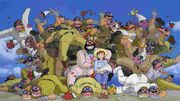
Fio posing for a photo with the Mamma Aiuto.
The crowd surges toward the shore. Porco and Curtis have exited their planes and their confrontation has turned into a fistfight in knee-deep shore water. As the fistfight continues, the two pilots begin to look pretty awful, with faces that are beaten to a pulp. It's a boxing match for endurance now, with a clang on a frying pan to mark the end of rounds. With eyes almost swollen shut, both fighters' punches miss entirely. But as Gina's plane pulls up, they simultaneously knock each other out and both sink into the water. The referee starts to count. Gina calls to Porco who rises from the waves on the count of ten. He won! Gina says to the crowd, "The festival is over now. Italian forces are coming to arrest you all," and everyone disperses. "Boss" gives Fio the prize money.
Porco throws Fio on Gina's plane despite her protests. Fio kisses Porco, who gets knocked in the head by the plane's wing. Then, Mr. Curtis and Porco remember that the Italian Air Force is coming to arrest them and so they, too, head for their planes. Porco flies off.
Cut to several years later. Fio keeps building planes, and every year, spends the summer at the hotel with Gina. Porco's plane can be seen parked by Gina's hotel as credits roll.
Characters[]
- Porco Rosso / Marco Pagot (ポルコ・ロッソ / マルコ・パゴット, Poruko Rosso / Maruko Pagotto)
- Shuichiro Moriyama (Japanese), Ward Sexton (JAL), Michael Keaton (Disney)
- The protagonist of this film, a man in the form of a humanoid pig with a mustache. According to the film's promotional booklet, Porco refused to return to the army and cast a spell on himself. The name "Porco Rosso" means "Red Pig" in Italian. He was born around 1892 - 1893 and is roughly 36 years old. He has been flying since he was 17 years old, and was promoted to captain after joining the Italian Air Force where he was active as an ace pilot during World War I. He retired and began working as a bounty hunter. He pilots a red Savoia S.21 prototype combat seaplane. He is known in the Adriatic for helping a downed enemy pilot who was caught in a stormy sea, and is a popular among women as a showboat.
- He is called "Porcellino" by Fio's family.
- In the original The Age of the Flying Boat, Porco was born in Genova, and he has the city emblem of Genova on the vertical stabilizer of his aircraft. Gina is his childhood friend.
- Madame Gina (マダム・ジーナ , Madamu Jīna)
- Tokiko Kato (Japanese), Faith Bach (JAL), Susan Egan (Disney)
- A widowed businesswoman who runs Hotel Adriano. In her youth, Gina formed a "Flying Club" with her friends and Porco. Thrice married to seaplane pilots, each ended in tragedy. As a widow, she goes by "Madame", which means "Mrs." in French. Gina is a beautiful woman, known as the Madonna of many seaplane riders, including air pirates. It is said that "every seaplane rider in the Adriatic Sea falls in love with Gina at least once."
- She has known Porco his whole life, and still calls him by his real name, "Marco". She harbors feelings for him which remain unrequited until the end. She is looking for a way to solve the magic that turned him into a pig. She also made a bet with him on "whether Porco would visit the private garden in the corner of the hotel during the day", and when he does, he will declare his love for her. She becomes friends with Fio through her relationship with Porco. She has a personal seaplane.
- Fio Piccolo (フィオ・ピッコロ , Fio Pikkoro)
- Akemi Okamura (Japanese), Lynn Eve Harris (JAL), Kimberly Williams-Paisley (Disney)
- Born around 1912 - 1913, and is 17 year old. Grandpa Piccolo's granddaughter and an airplane design engineer. Her father, who was also an engineer, was a former Air Force pilot and belonged to the same unit as Porco's during the war. Fio has had training experience in the United States and was entrusted by Porco with the redesign of his Savoia S.21.
- She accompanies Porco, who is forced to leave Milan without giving his newly repaired plane a proper flight test. She explains, "I want to take responsibility for my work to the very end". She is courageous enough to scold the entire Air Pirates Union, and even helps set up a rematch between Porco and Donald Curtis. Gina becomes a close friend following their rematch and she later takes over the Piccolo family business.
- Grandpa Piccolo (ピッコロのおやじ , Pikkoro no Oyaji)
- Katsura Bunshi (Japanese), Clay Lowrey (JAL), David Ogden Stiers (Disney)
- Fio's grandfather and the owner of Piccolo S.P.A., a seaplane manufacturer in Milan, Italy. He's an old friend of Porco. He's aware of Porco's predicament and offers to help repair his plane, for a price. He recognizes the enthusiasm and skill of his granddaughter, and has her brought in to redesign and repair Porco's Savoia S.21. He also has three other sons, who were absent due to being migrant workers. He then calls in all his female relatives to help operate his factory.
- Capo/"Boss" (マンマユート・ボス , Manmayūto Bosu)
- Tsunehiko Kamijō (Japanese), Brad Garrett (Disney)
- The "Boss" of the air pirate group Mamma Aiuto, who fly around in a Dabohaze seaplane. He has a large red nose, a beard, and a flying cap and goggles. The literal translation of Mamma Aiuto "Help Mom", but according to The Age of the Flying Boat comic, it meant "Mama Scary Group". While "Boss" possesses a gruff exterior, he has the integrity to admit whether he's wrong, and is also kind to women and beloved by his subordinates. He is also one of the few people who knows of Porco's past.
- Donald Curtis (ドナルド・カーチス , Donarudo Kāchisu)
- Akio Otsuka (Japanese), Greg Dale (JAL), Cary Elwes (Disney)
- An American born in Alabama, his grandmother is an Italian quarter (Immigrants from Southern Italy that settled in the United States in the 1850's). The American version released by Disney changed his origins to Texas. His personal aircraft is the fictitious Curtiss R3C-0, a non-public surface fighter modeled after the Curtiss R3C-2 . He's a mercenary hired by the Air Pirates Union and a rival to Porco. A highly skilled pilot that even Porco acknowledges. He falls in love with Gina at first sight.
- Following his rematch with Porco, he returned to the United States and became the leading actor in a western drama. Becoming an air pirate mercenary and a movie actors were just stepping stones to his ultimate goal of life. The film poster which starred Curtis follows the layout of an actual movie that starred President Ronald Reagan.
- In the original The Age of the Flying Boat, he calls himself Donald Chuck, and "Curtis" is a nickname associated with his favorite aircraft.
Setting[]
History and Politics[]
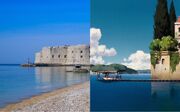
Hayao Miyazaki, Mamoru Oshii, Toshio Suzuki traveled to Italy for location scouting.
Porco Rosso is one of the few films directed by Hayao Miyazaki in which the historical and geographical settings are clearly defined and where most of the story could have happened in the real world. Marco is an Italian hero from the First World War and is shown fighting against Austro-Hungarian fighter planes in a flashback sequence. The story is set in Northern Italy, including Milan, and the Adriatic Sea east coast, including Dalmatia in modern-day Croatia. Some locations resemble specific islands of the Italian lakes. The concealed beach Porco uses as a hideout bears a strong resemblance to Stiniva Beach, on the southern side of the Croatian island of Vis.

The tone of the film changed due to Miyazaki being aware of the Yugoslavian Civil War which began in 1991.
Porco makes statements of his being anti-fascist, quipping during one scene that "I'd much rather be a pig than a fascist". Miyazaki shed light on the political context of the making of the film in an interview with Empire. He reflects that the conflicts that broke out during the film's production (such as those in Dubrovnik and elsewhere) made Porco Rosso a much more complicated and difficult film.
Evident historical and political realism aside, at least one scholar has argued that the film's more overt historical references can be understood as representative of wakon yosai (Japanese spirit; Western techniques)—a tendency, since the Meiji period, for Japanese artists to paint Europe as spectacular, while simultaneously maintaining the distance necessary to preserve a distinct sense of Japanese identity. "In Porco Rosso," states academic Chris Wood, "Europe is tamed, rendered as a charming site of pleasurable consumption, made distant and viewed through a tourist gaze."
Homage to Early Aviation[]
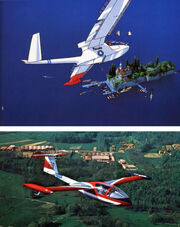
The ending is set several years after the events of the film, with Fio piloting a jet-powered plane she designed (her family name "Piccolo" can be seen on the side). The design is similar to the Caproni C-22J.
The fictional Piccolo seaplane repair company depicted in the film may be a reference to the Italian aircraft manufacturers Caproni and Piaggio. The jet shown in the last scene is very similar in concept to the Caproni C-22J, an aircraft designed by Carlo Ferrarin, a designer for Caproni, whose name is notably used in the film for Marco's Air Force pilot friend. The Jet-amphibian also has a V-tail, slightly reminiscent of the Magister jet trainer.
Porco's air-force friend Ferrarin was inspired the Italian Air Force pilot Arturo Ferrarin who flew with an Ansaldo SVA.9 from Rome to Tokyo in 1920. Additionally, the Caproni Ca.309 light reconnaissance aircraft is known under the name "Ghibli", the same name as Miyazaki's and Takahata's animation studio.
While in Piccolo's engine shop, the engine to be used in the Porco's rebuilt Savoia S.21 also has the word "Ghibli" visible on its rocker covers—in design it is a narrow-angle V-12 engine, similar in form to racing engines of the period. Grandpa Piccolo mentions that it was used in a racing aeroplane for the Schneider Trophy race in the year before.
In the early 1930s, Italian seaplane designers set world speed records (such as the Macchi M.C.72 designed by the Italian airplane designer Mario Castoldi). One of the test pilots killed during the attempt to set the speed record was named Bellini, the name given to Porco's pilot friend in the film.
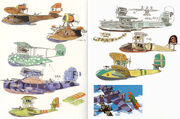
Porco Rosso highlighted Miyazaki's love for seaplanes, which included designs as the Savoia S.21, Savoia S.M55M, Macchi M.5 and many more.
Marco Pagot, the name of the main character, is also a homage to the Pagot brothers, pioneers of Italian animation (Nino and Toni Pagot were the authors of the first Italian animated feature film, The Dynamite Brothers, and his sons Marco and Gi Pagot were Miyazaki's collaborators in the production of Sherlock Hound).
Meanwhile, the character of Curtis is likely to have been named after the American aviation pioneer Glenn Hammond Curtiss who, along with the Wright Brothers, founded the Curtiss-Wright Corporation. Curtis' airplane is a Curtiss R3C-0, which was built for the 1925 Schneider Cup race (which Porco refers to when he first meets Curtis). His character is also an oblique reference to Ronald Reagan, in that his ambitions lie not only in Hollywood, but also the Presidency. The rest of Curtis' character appears to come directly from the adventure film heroes portrayed by Errol Flynn at this time—indeed, they share a jaw line—including his buccaneering derring-do, willingness to fight, and overall demeanor combined with romantic ardor. Miyazaki revisited the theme of aviation history in his 2013 film The Wind Rises.
Behind the Scenes[]
Early Concept[]
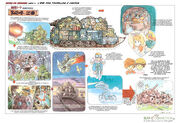
The comic Tahôtô no Deban featured the multi-turret Akuyaku tank. It was originally going to be adapted by Hayao Miyazaki before he settled on Porco Rosso.
The initial story, inspired by the illustrated essay Tahôtô no Deban (多砲塔の出番 , The Age of Gun Turrets) that Miyazaki created in 1984, was as follows. A former military officer, a pig leaves his command, builds a tank and sets out in search of fun and glory. He kidnaps a young woman with whom he falls in love and tries in vain to seduce her. “As I continued to work on the story, I thought of a happy ending where the pig's love conquers the girl's heart. At first, the latter was supposed to be an ordinary girl, waitress in a road restaurant. But the character was changed and she became a singer in a bar like Marilyn Monroe in "The River of No Return", just a little younger and purer." But the young director in charge of directing did not believe that a mature man could sincerely love a young woman he kidnapped and succeed in winning her heart. Not being able to agree with Miyazaki on the script, he leaves and the project falls through.
A few years later, Miyazaki tells Comic Box that he has not given up on the idea of making "a not serious movie in which I would show my embarrassing side ... The truth is that I am happy when I write stupid stories of planes and tanks in magazines like Model Graphix [...] . But animation requires enormous teamwork. A movie can only be made by an organization and it is difficult to get them to work on a frivolous project. So sometimes I dream of making a stupid movie with my own money, a video (OAV) that wouldn't even allow me to recoup my expenses."
Planning[]
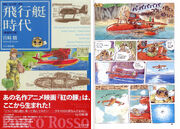
The Age of the Flying Boat, published in 1990 featured the titular Porco Rosso.
This idea resurfaced when Miyazaki drew The Age of the Flying Boat, a watercolor manga for Hayao Miyazaki's Daydream Data Notes and was serialized by Monthly Model Graphix from its March (issue was released on February 25, 1990) until May issue.[1] Miyazaki, whose had a lifelong fascination with aviation, drew this comic for his own pleasure. He moved quickly to adapt it, stating he wanted to make a "manga movie for middle-aged men who were tired and whose brain cells became tofu." They also considered producing Assault! Iron Pork! (突撃!アイアンポーク , Totsugeki! Aian Pōku) a comic that was also featured in Miyazaki's Daydream Data Notes, but was cancelled due to various reasons.[2]
The film would reflect Miyazaki's personal hobbies and wasn't meant for children. Asked, in an interview, about what inspired him, the master replied: “I like seaplanes. Although I make films for children, this film was made because I wanted to express my love for these planes. Until I was done Princess Mononoke, I felt a little guilty - but not too much - for having involved the studio in a personal project. "On the other hand, he said, "It was fun as a hobby to revive an aircraft that even Italians had forgotten and to create an air force that does not exist." Despite his misgivings, he felt very strongly about the film, to the point where he considered producing a sequel.
Production[]
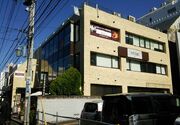
The original office of Studio Ghibli used since its founding until the production of Porco Rosso. They relocated to a new office designed by Hayao Miyazaki in Kogenai City.
The proposal for the film was completed on February 26, 1990. Toshio Suzuki proposed an in-flight 45-minute animated short in partnership with Japan Airlines to coincide with the company's 40th anniversary. They were given a 200 million yen budget and production was scheduled to begin in November 1990 and completed in August 1991. According to one of Miyazaki's essays, in order for Studio Ghibli to continue as a viable company, they needed to constantly be working on film projects.[3] At the time, the main animation staff was busy working on Isao Takahata's film, Only Yesterday and were facing numerous delays. Thus in March 1991, Miyazaki began preparing for the film's production alone, sans animation staff.
Fearing delays, Miyazaki considered hiring newcomers but was afraid that quality would deteriorate. Miyazaki then proposed appointing Ghibli's female staff to be in charge of the animation. This was considered groundbreaking at the time as animation production in Japan was mainly done by men. Suzuki accepted Miyazaki's proposal and production went back on track. Thus despite the film being marketed towards older men, the production was mainly composed of women. This fact was even alluded to in the film as Mr. Piccolo's workshop was mainly composed of women. The number of drawings reached 58,443 and 476 colors were used.[4] The production period was set to last eleven months, from March 1, 1991, to June 12, 1992, and would employ nearly 250 people.
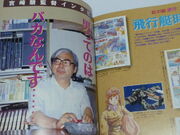
A guidebook to Porco Rosso by Kodansha, featuring Miyazaki.
In September 1990, Toshio Suzuki, the animation director Mamoru Oshii, Miyazaki and several other producers conducted location scouting at the Tiber River in Italy and Rome.
As the film was geared towards an older male audience, it featured two female characters, namely Fio and Gina. The resulting relationship between Porco and the female leads never resulted beyond a kiss in the cheek, mirroring Lupin III and Clarisse's relationship in The Castle of Cagliostro.[5]
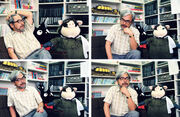
Hayao Miyazaki in an interview with the Asashi Shumbun.
Meanwhile, Toho, Tokuma Shoten, and Nippon Television joined the production committee, motivated that it would be a "Hayao Miyazaki's movie". The film's runtime was originally 30 to 45 minutes, then 60 to 80 minutes, and finally extended to feature film-length of 90 minutes due to the inclusion of a flashback war scene, influenced by the outbreak of the Gulf War (August 1990) and Yugoslavia (March 1991). Miyazaki himself worried setting the film in the Yugoslavian archipelago would seem insensitive as the region was facing actual war.[6]
During the film's production announcement press event, producer Toshio Suzuki unveiled a promotional trailer that made the film seem as if it would be a war movie filled with exciting air battle sequences. Miyazaki was reportedly furious at this as it did not showcase the story's direction at all. At the same time, the conflict in Europe was still ongoing, which also added to Miyazaki's anger. Miyazaki reportedly cursed Suzuki in front of reporters.
Release[]
| Country | Release Date | Format | Publisher |
|---|---|---|---|
| Japan |
July 18, 1992 | Theater | Toho |
| Japan |
September 1995 | VHS | Tokuma |
| Japan |
Autumn 1999 | VHS Re-Release | Tokuma |
| USA |
2003 | English Dub | The Walt Disney Company |
| Japan |
March 2004 | DVD/VHS | Tokuma |
| USA |
June 2003 | DVD | The Walt Disney Company |
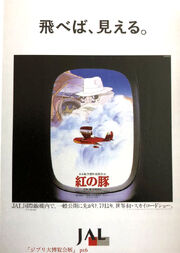
The Japan Airlines poster for the film.
Yasuyoshi Tokuma, chairman of Tokuma Shoten and executive producer of Porco Rosso remained bitter despite helping fund the success of both My Neighbor Totoro and Grave of the Fireflies. Indeed, in 1988, Tokuma, in cooperation with his Chinese partners, released a film he was very fond of called The Silk Roads (敦煌 (映画), based on a novel by Yasushi Inoue. Due to "Totoro's" overwhelming box office success and Grave of the Fireflies critical success that same year, The Silk Roads was totally eclipsed.
When the release date of Porco Rosso was announced for July 18, 1992, Tokuma decided to release the sequel to The Silk Roads called Dreams of Russian (おろしや国酔夢譚) on the very same date. Tokuma couldn't help stir up competition between his own productions. He ramped up promotions for Dreams of Russian, even going so far as to contact the president of Nippon Television, along with Toshio Suzuki, to convince them to leave Porco Rosso with much less advertising support. Fortunately, Ghibli's film was a massive box office success, proving that the success of their previous film, Kiki's Delivery Service (1989) wasn't a fluke.[7]
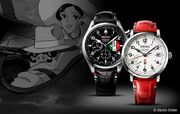
Seiko released a special tie-in watch with the film.
Japan Airlines remained a major investor of the film, and showed it as an in-flight film a few weeks before its theatrical release. Due to this, the opening text introducing the film appears simultaneously in Japanese, Italian, Korean, English, Chinese, Spanish, Arabic, Russian, French and German. In September 2007, Porco Rosso was re-screened abord JAL's international flights. While Miyazaki was working on the film, he was also busy designing the new studio for Studio Ghibli.
The theatrical poster's advertising slogan are "This is what it means to be cool." and "The pig that doesn't fly is just a pig." while the JAL poster's slogan is "If you fly, you can see". They were coined by Shigesato Itoi.
French Version[]
In September 1995, Animage magazine published a double page spread regarding the French dubbed release of Porco Rosso. Hayao Miyazaki gave the following statement:
“I saw the French version “Porco Rosso” on video. I have been interested in Jean Reno as an actor since I saw The Big Blue (1988). I was just happy. As for Fio (Adèle Carasso), her voice matched the character I imagined and it was nice. If I look at the photo of Curtis (Jean-Luc Reichmann) and Gina (Sophie Deschaumes) voice actors, they are voiced by actors who look like them and it's funny. They had a way of speaking without much intonation. The way they acted was very natural in the film. On the other hand, in Japanese, I think it was an eccentric way of speaking and a little too forced.
On the other hand, I appreciated that people who saw the movie didn't ask why he's a pig. When the movie came out in Japan, I was asked for that and it was embarrassing. I want the public to welcome this film as a European story.
Another thing I liked was the poster for the French version. This discount blue reminds me of the Gitanes cigarette pack. It is very frivolous. I need to send this poster to Tokiko Katô (Gina's Japanese voice)! (Laughs)"
Reception[]
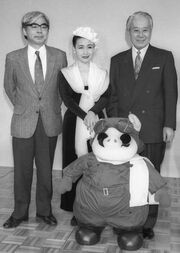
From left: Hayao Miyazaki, Tokiko Kato, Shuichiro Moriyama (Kyodo News).
Porco Rosso was the number one film on the Japanese market in 1992, earning ¥2.713 billion in distribution income. Despite the film being geared towards an older audience, a recorded 3,049,806 were said to have seen the film. Even Hayao Miyazaki was reportedly surprised at its success, as it further cemented Studio Ghibli's legacy as a hit maker in the industry. Their next few films would be lowkey affairs such as Pom Poko (1994), On Your Mark (1995) and Whisper of the Heart (1995) until Princess Mononoke (1997).
It won the Animation Film Award for the 47th Mainichi Film Awards Music Award. Additionally, it won the 5th Nikkan Sports Film Award and Agency for Cultural Affairs Excellent Film Award. It was selected as the Prix du long métrage (Featured film) at the 1993 Annecy International Animated Film Festival.
It also made Time Outs top 50 animated movie list. On Rotten Tomatoes, the film has a rating of 94% based on 16 reviews. Wilson McLachlan, of the Left Field Cinema, considered it "the most underrated film from the Studio Ghibli catalogue."
Sequel[]
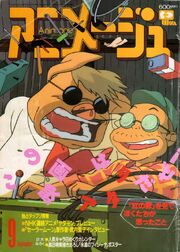
Tokuma Shoten's Animage magazine promoting Porco Rosso.
In 2011, Miyazaki said that he wanted to make a follow-up anime to the 1992 original film if his next few films following Ponyo on the Cliff by the Sea were successful. During the production of The Secret World of Arrietty, Miyazaki was asked regarding the sequel saying he was interested and added that "The ending was changed for that purpose". He affirmed this by saying, "I want to do a sequel to Porco Rosso" and "The title is 'Porco Rosso: The Last Sortie'". The film would be set during the Spanish Civil War with Porco also returning, albeit this time as an old pilot, reflecting Miyazaki's own aging.[8]
Shuichiro Moriyama, the voice of Porco, later said, "(Miyazaki) announced his retirement, but if he does not produce Part II, the story will never be completed I would like you to fulfill your promise somehow." Miyazaki was set to write the film, but Hiromasa Yonebayashi direct but to both Miyazaki and Yonebayashi's departure from Ghibli and the current hiatus of the studio itself, the current status on the proposed sequel remains uncertain.
Music[]
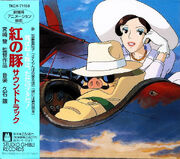
Porco Rosso's official soundtrack.
Porco Rosso (Image Album) (紅の豚 イメージ アルバム , Kurenai no Buta Imeeji Arubamu) is a 10-track album composed by Joe Hisaishi and released by Tokuma Japan Communications on May 25, 1992.
Porco Rosso (Original Soundtrack) (紅の豚 サウンドトラック , Kurenai no Buta Saundotorakku) is an album composed by Joe Hisaishi released by Animage Records and Tokuma Japan Communications on July 25, 1992. It is Hisaishi's fifth collaboration with Miyazaki.
Hisaishi had been working on his 1920's themed solo album My Lost City (released February 12, 1992) when he was hired to work on Porco Rosso. After Miyazaki was sent both My Lost City and the Porco Rosso (Image Album), he said "I love ("My Lost City"), I want it all for Porco Rosso. Please replace it with the Image Album". As a result, the opening song of the film is very similar to the song "1920 ~ Age of Illusion" from My Lost City. Additionally, the track "Two of Us" is literally the theme of the film.
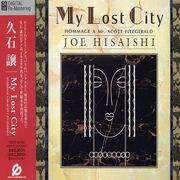
Joe Hisaishi's solo album My Lost City served as a basis for the film's official soundtrack.
During an interview with producer Toshio Suzuki on June 4, 1992, Hisaishi recalls the challenges he faced composing the film's score "Both Director Miyazaki and I don't like to compromise with each other (laughs). This raised tension between our collaboration, but I think that led to a higher level of quality to the work. Also, this time, I was particular about the acoustics and recorded almost with a full orchestra of 70 people."
"It's a movie that expresses Miyazaki-san's personal feelings quite strongly. I wasn't very good at the way music should go when Mr. Miyazaki came to the fore. If anything, I should have pulled it, but since the setting is flight across the Adriatic Sea, the part that seems to be a little swashbuckler, and the part that is really personal, maybe I Maybe he didn't understand this work very much. I still reflect on that for a moment.
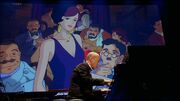
Joe Hisaishi performing the theme to the film during the 2008 anniversary concert Joe Hisaishi in Budokan.
Suzuki responds, "No, it was wonderful. Don't forget, Mr. Hisaishi came to the studio and Miyazaki ordered "Please make an embarrassing song! Please liven it up!". When I watch various movies, most of the songs don't get excited when they telegraph it's an exciting scene, and I'm tired of listening to all those songs. However, Mr. Hisaishi brilliantly met his expectations for the songs that really liven up there, and I wanted him to do it. That's why I remember Miyazaki being overjoyed when that song was made."
Hisaishi then says, "Personally, it's like the movie "Casablanca". It's nostalgic, but it's like a man's coolness, and I wish I could see something like that."
Suzuki, "I really liked Miyazaki inserting himself in one shot. (While Gina was singing in the bar) I liked Miyazaki-san playing on the piano, it really worked."[9]
Singer and activist Tokiko Kato, aside from voicing Gina, also sang the theme and ending song. The ending song "The Bygone Days" was used in response to the insert song "The Time of Cherries". "The Bygone Days" is an original song written and composed by Tokiko Kato and released in 1987, seven years before it was used for the film. Miyazaki's main inspiration is how the 1920s was described as the "Jazz Age".
Soundtrack[]
- "The Wind of Time (When a Human Can Be a Human)" – 2:50
- "MAMMAIUTO" – 1:21
- "Addio!" – 0:37
- "The Bygone Days" – 2:16
- "A Sepia-Coloured Picture" – 0:47
- "Serbia March" – 1:03
- "Flying Boatmen" – 2:36
- "Doom (Cloud Trap)" – 1:23
- "Porco e Bella" – 1:06
- "Fio-Seventeen" – 2:04
- "The Women of Piccolo" – 2:04
- "Friend" – 3:04
- "Partnership" – 2:28
- "Madness (Flight)" – 2:39
- "To the Adriatic Sea" – 1:50
- "In Search of the Distant Era" – 2:18
- "Love at First Sight in the Wildness" – 1:11
- "At the End of Summer" – 1:26
- "Lost Spirit" – 4:11
- "Dog Fight" – 2:10
- "Porco e Bella (Ending)" – 2:35
- "The Time of Cherries" (sung by Tokiko Kato, arrangement by Yoko Kanno) – 2:52
- "Once in a While, Talk of the Old Days" (composition, lyrics, vocals by Tokiko Kato, arrangement by Yoko Kanno, Junichiro Ohkuchi) – 3:56
Trivia[]
- Porco Rosso's poster appears also Kichijoji Station in Ocean Waves when Taku meets Rikako. Porco Rosso himself appears sitting on a table at the school fair.
- This vision Porco has of hundreds of fallen pilots and their planes soaring to the sky is said to have been inspired by Road Dahl's short story, They Shall Not Grow Old. The shot of ghost planes flying in the distance was later riffed in The Wind Rises.
- In Whisper of the Heart, when Shizuku is shown the grandfather clock by Mr. Nishi, Porco Rosso is written on the clock face.
- Porco Rosso makes a cameo appearance during the "goblin parade" scene in Takahata's Pom Poko, where he is seen flying on his red plane.
Cast[]
Additional Voices[]
- Original: Katsuyo Endou, Shinnosuke Furumoto, Masayuki Inagaki, Daisuke Inoue, Ayumi Kida, Ginzo Matsuo, Akio Matsuoka, Rie Morita, Hirotsugu Moriyama, Hiroko Nakatsugawa, Atsuko Nakazawa, Akimasa Ohmori, Hirozumi Satoh, Maiko Satoh, Yuri Satou, Yutaka Shimaka, Yoko Soumi, Wakana Takahashi, Fumiko Taneda, Gekidan Wakakusa
- Disney English Dub: Michael Bell, Cameron Bowen, Dee Bradley Baker, Jennifer Darling, Debi Derryberry, Greg Ellis, Pat Fraley, Sherry Lynn, Mickie McGowan, Laraine Newman, Rob Paulsen, Deanna Russo, Jim Ward
Credits[]
| Credit | Staff |
|---|---|
| Director, Screenplay, Storyboard | Hayao Miyazaki |
| Character Design | Toshio Kawaguchi |
| Art Director | Katsu Hisamura |
| Animation Director | Megumi Kagawa, Toshio Kawaguchi |
| Key Animation | Akiko Hasegawa, Atsuko Otani, Hiroko Minowa, Hiroshi Shimizu, Katsuya Kondo, Kenichi Yoshida, Mahiro Maeda, Makiko Futaki, Masaaki Endou, Masako Shinohara, Masashi Ando, Mitsuo Iso, Noriko Moritomo, Sachiko Sugino, Shinji Morohashi, Shinji Otsuka, Shinya Ohira, Yoshifumi Kondō, Yoshiharu Satō, Yoshinori Kanada, Yoshiyuki Momose, Yuu Isomitsu, Yuuji Shigekuni |
| In-between Animation | Akiko Teshima, Atsuko Matsushita, Atsushi Hasebe, Emiko Iwayanagi, Eriko Shibata, Hideaki Yokoi, Hideaki Yoshio, Hideki Ito, Hiroaki Akagi (Telecom Animation Film), Hiroko Tezuka, Hiromi Furuya, Hiroyuki Inoue, Hisako Sueda, Katsutoshi Nakamura, Kazuko Shibata, Kazumi Sakai (Telecom Animation Film), Kazumi Yokoyama, Kazuyoshi Onoda, Keiko Yozawa (Telecom Animation Film), Ken Baba (Telecom Animation Film), Kenichi Konishi, Kenichi Yamada, Kiyoko Makita, Koichi Asano, Kouji Shinozaki, Kumi Horii, Kumiko Ohta, Makoto Ozawa (Studio Pierrot), Masahiko Adachi, Masahiko Ohraku (Telecom Animation Film), Masako Sakano, Masaru Matsuse, Masatoshi Nakamura, Masaya Saito, Masaya Yasutome (Telecom Animation Film), Mayu Yazawa (Telecom Animation Film), Mayumi Ohmura, Mayumi Shimizu, Mayumi Shoji (Telecom Animation Film), Michiko Okada, Nobuko Sato, Reiko Mano, Rie Kondo, Rie Niidome, Ritsuko Shiina, Sachiko Okada, Sawako Miyamoto (Telecom Animation Film), Seiko Higashi, Shigeru Kimishima (Studio Pierrot), Shinobu Tsuneki, Shinsaku Sasaki, Sumie Nishido, Takao Maki, Takasumi Matsukawa (Telecom Animation Film), Takehiro Noda, Takeshi Inamura, Tsuyoshi Konakawa, Yasuko Ohtomo, Yoko Kida, Yōko Nagashima, Yukari Yamaura, Yukiko Shimizu (Telecom Animation Film), Yumiko Kitajima, Yuuko Sotake (Telecom Animation Film) |
| In-between Check | Hitomi Tateno, Rie Fujimura, Rie Nakagome |
| Photography | Hidekazu Shinya, Hiroshi Fukuda, Hiroshi Sakakibara, Hiroyuki Matsuzawa, Junji Yabuta, Kumiko Taniguchi, Shuichi Ito, Shuji Fujikura, Tohru Osakabe, Toshiyuki Umeda |
| Planning | Hideo Ogata, Tatsumi Yamashita |
| Background Art | Akira Yamakawa, Kazuo Oga, Kiyomi Oota, Kyōko Naganawa, Naomi Sakimoto, Naoya Tanaka, Satoshi Kuroda, Youji Takeshige |
| Color Design | Michiyo Yasuda |
| Finish Animation | Akemi Hosotani (Studio OZ), Akihiko Isozaki (Studio OZ), Akiko Ono, Chieko Omachi (IM Studio), Eiko Fukuma (IM Studio), Homi Abe, Junko Moritsugu (Studio Pierrot Fukuoka), Junko Yoshikawa, Kanako Moriya, Kazuhiro Hirabayashi (Studio Killy), Kumiko Nishio (Studio Killy), Mariko Konuma (IM Studio), Masami Sasagawa (Kyoto Animation), Masayo Iseki, Masayo Sakai (Studio Killy), Mayumi Watabe (Studio Killy), Michiko Shibata (IM Studio), Michiyo Iseda (IM Studio), Minako Oshiro, Miyoko Oka (Studio Killy), Naomi Mori, Naomi Takahashi (Studio Killy), Nobuko Watanabe (Studio Killy), Noriko Ogawa, Rie Takagi (Kyoto Animation), Sayuri Matsuo (Studio Pierrot Fukuoka), Shizuko Iwasaki (Studio Pierrot Fukuoka), Takiko Kubota (Studio Killy), Terumi Narita (IM Studio), Yasuko Suenaga (Studio Killy), Yasuyo Takayama (IM Studio), Yoko Sakamoto, Yoko Tanida (IM Studio), Yukari Tajima (IM Studio), Yuki Hisada, Yukie Kitsukezawa, Yukie Kuroki (Studio Killy), Yukiko Shimokawabe (IM Studio), Yukimi Toyonaga, Yumi Furuya, Yumiko Uehara (Studio Pierrot Fukuoka), Yuriko Katayama |
| Executive Producers | Matsuo Toshimitsu, Sokai Tokuma, Yasuyoshi Tokuma, Yoshio Sasaki |
| Producer | Toshio Suzuki |
| Music | Joe Hisaishi |
| Production | Studio Ghibli |
Related Products[]
Home Video[]
- Porco Rosso VHS - Tokuma Shoten (December 21, 1992)
- Porco Rosso LD -Tokuma Shoten (June 15, 1997)
- Porco Rosso VHS- Buena Vista Home Entertainment (April 23, 1999)
- Porco Rosso DVD-Buena Vista Home Entertainment (March 29, 2002)
- DVD (Director Hayao Miyazaki's Works) -Walt Disney Studios Japan (July 2, 2014)
- Porco Rosso Blu-ray Disc-Walt Disney Studios Japan (July 17, 2013)
- Blu-ray Disc (Director Hayao Miyazaki's Works) --Walt Disney Studios Japan (July 2, 2014)
Publishing[]
- "The Age of the Flying Boat" (Dainippon Painting, July 1992) ISBN 4-499-20595-6
- "The Age of the Flying Boat" (Supplementary Revised Edition: Dainippon Painting, November 2004) ISBN 4-499-22864-6
- Porco Rosso (THIS IS ANIMATION) (Shogakukan, August 20, 1992) ISBN 4-09-101536-0
- Sometimes old stories talked by Hayao Miyazaki and Tokiko Kato (Tokuma Shoten, August 31, 1992) ISBN 4-19-554946-9
- Porco Rosso-Film Comic (1) (Tokuma Shoten, September 20, 1992) ISBN 4-19-772090-4
- Porco Rosso-Film Comic (2) (Same as above, September 20, 1992) ISBN 4-19-772091-2
- Porco Rosso-Film Comic (3) (Same as above, October 25, 1992) ISBN 4-19-772100-5
- Porco Rosso-Film Comic (4) (Same as above, October 25, 1992) ISBN 4-19-772101-3
- The Art of Porco Rosso (Tokuma Shoten, October 30, 1992, New Edition May 1997) ISBN 4-19-812100-1
- Romantic Album Porco Rosso (Tokuma Shoten, November 1, 1992, New Edition May 2001) ISBN 4-19-720160-5 .
- Studio Ghibli Works Related Materials IV (Studio Ghibli, December 31, 1996) ISBN 4-19-860628-5
- Porco Rosso (Studio Ghibli Storyboard Complete Works 7) (Tokuma Shoten, September 30, 2001) ISBN 4-19-861424-5
- Ghibli Textbook 7 Crimson Pig (Studio Ghibli Edition, Bungei Shunju < Bungei Ghibli Bunko >, September 10, 2014) ISBN 978-4-16-812006-0
- Cinema Comic 7 Porco Rosso (Bungei Shunju <Bungei Ghibli Bunko>, September 10, 2014) ISBN 978-4-16-812106-7
Music[]
- Porco Rosso Image Album - Tokuma Japan Communications ((Reissue CD / May 21, 1997) TKCA-71155 (Original Edition / May 25, 1992))
- Porco Rosso Soundtrack "Flying Pig is just a pig!" Tokuma Japan Communications ((Reissue CD / May 21, 1997) TKCA-71156 (Original Edition / July 22, 1992))
- Porco Rosso Drama Edition I wonder how the magic cast on you can be solved Tokuma Japan Communications (September 25, 1992) TKCA-30663
- Studio Ghibli Hayao Miyazaki & Joe Hisaishi Suntra BOX [Box set, Limited Edition] (CD) Tokuma Japan Communications (July 16, 2014)
Other Related Books[]
- Hayao Miyazaki Movie Wind (Author: Sora no Kai, Sojusha, December 1993)
- Hayao Miyazaki's Miscellaneous Notes (enhanced and revised edition) (Dainippon Painting, August 1997) ISBN 4-499-22677-5 . First edition, December 1992
Plastic Models[]
- Savoia S.21F Forgore "Original version / Late model" 1/72 scale (Fine Molds)
- Savoia S.21 Prototype combat flight boat 1/48/1/72 scale (Fine Molds)
- Savoia S.21F "Late model" 1/48/1/72 scale (Fine Molds)
- Curtiss R3C-0 Non-public surface fighter 1/48/1/72 scale (Fine Molds)
- Savoia S.21 Prototype combat flight boat 1/72 scale painted finished product (Fine Molds)
- Savoia S.21F "Late model" 1/72 scale painted finished product (Fine Molds)
References[]
- ↑ Reprinted in "Hikotei Jidai - Original Movie" Porco Rosso" (Dainippon Painting, 2004)
- ↑ "Miyazaki Hayao's Miscellaneous Notes" p.103.
- ↑ Miyazaki Hayao Writing Case (宮﨑駿 書き置き事件).
- ↑ "Why did the movie "Porco Rosso" Porco become a pig? What is the message contained in this work?", Filmaga
- ↑ "Hayao Miyazaki was impatient with overdoing Gahaha with "Porco Rosso", Excite JP
- ↑ "Thorough dissection of the Porco Rosso!!", Homemate.
- ↑ "Porco Rosso: Creation of the film", Buta Connection
- ↑ "News that "Porco Rosso" sequel is being planned in the United States!", Cinema Today
- ↑ "Joe Hisaishi "Porco Rosso Sound Track", Hibikihajime No Heya.
External Links[]
Official Sites
 Porco Rosso on GKIDS
Porco Rosso on GKIDS
Information
Encyclopedia
- Porco Rosso on Wikipedia
[]
| |||||||||||||||||||
